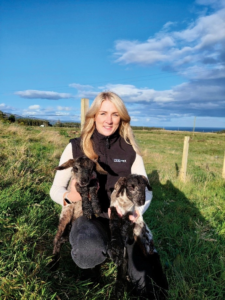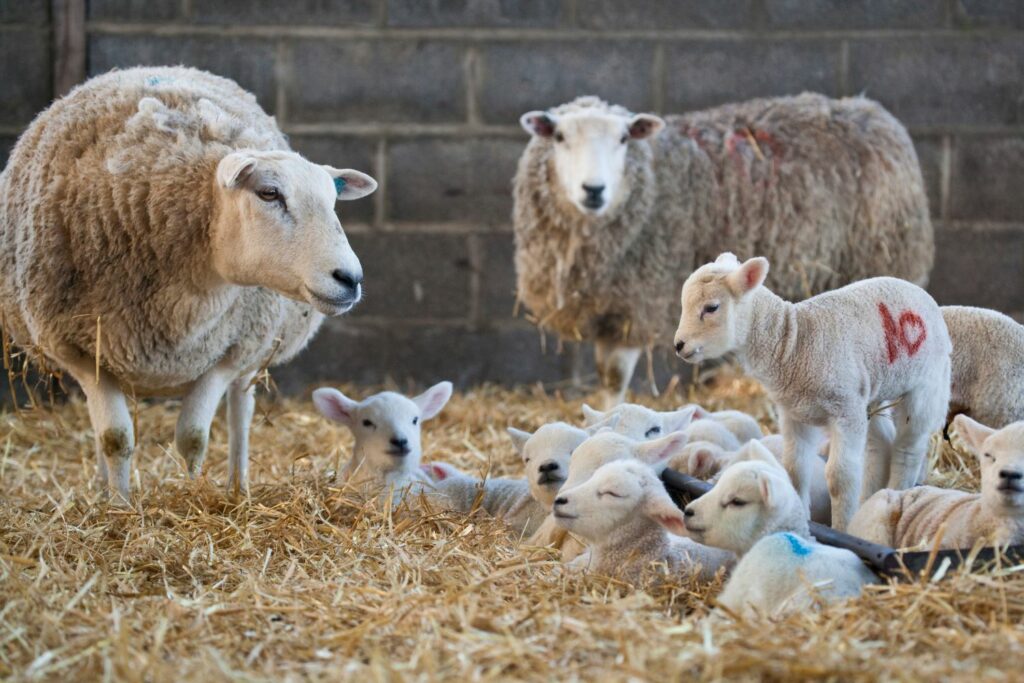Planning your lambing checklist now could be “a huge time saver”
17th November 2022
Lambing season is by far the most demanding time of year for sheep farmers, which is why livestock farmers and Nettex area business managers, Jane Moodie and Gwyn James recommend taking a checklist approach to pre-lambing preparation.
“There isn’t another time of the year that is as labour intensive as lambing season and if you are unprepared, it can be difficult to keep up with everything,” said Nettex area business manager Jane Moodie, whose family farm grazes 200 ewes in the Scottish Highlands.
Miss Moodie and fellow Nettex area business manager Gwyn James recommend that farmers start planning well ahead of lambing season and set aside time in the coming weeks to organise management schedules and take stock of lambing supplies.
Mr James, 42, who has helped his father lamb their flock of 300 ewes since he was old enough to work, also balances a full-time job with hands-on work on the family farm. He found writing checklists and staying organised in the weeks running up to lambing season helped things run more smoothly and efficiently.
“Taking the time to prepare and be organised is ultimately a small investment into a huge time saver for the future,” he pointed out. “Especially when it comes to having the right supplies on hand.
Mr James and Miss Moodie suggested creating two checklists; one for management tasks such as scanning dates, pen setup, and nutrition planning, and one for equipment supplies.
To help farmers with the upcoming lambing season, Nettex is giving away three £500 vouchers for Nettex products. Farmers can enter the draw until 31st March 2023 by filling out a four-question survey here.
Below, Mr James and Miss Moodie share what they consider essential to have on a pre-lambing equipment checklist for indoor and outdoor systems:
- Boxes of gloves – long and short
Miss Moodie, who spent some years working as a veterinary nurse, is insistent on wearing gloves when lambing to protect both the flock and the handler.
“I like wearing long ones that go up my arm when lambing because the mucous on lambs dries out and cracks skin, creating the perfect opportunity for bacteria to enter into your body and cause some serious issues,” she cautioned.
“It is also important to wear clean gloves between handling sheep, especially when doing something like trimming feet, to prevent the spread of infection from one sheep to another.”
- Iodine – spray or dip
While both dipping and spraying navels protect lambs from infection, Mr James has a clear preference regarding ease of use:
“I find the cup method for dipping navels to be very wasteful and messy and prefer to use 10% iodine spray. This dries rapidly and if applied properly will give the same coverage as a dip,” Mr James said.

Scottish livestock farmer and Nettex area business manager Jane Moodie.
- Colostrum
While allowing a lamb access to colostrum from the ewe as soon as possible after lambing is considered best practice, if this is not an option or in case the ewe rejects the lamb, it is recommended to have some powdered colostrum on hand.
“Weather conditions and other factors will also have a significant impact on colostrum production so if a bad weather front is going to be moving in, definitely increase the amount of powdered colostrum you have available,” she added.
Both Miss Moodie and Mr James use Nettex Ultra Concentrate, a high-quality lamb colostrum sourced from British farms.
- Marker spray
“We use this for management notes for things like pairing twins or if they’re a male and have been banded,” explained Miss Moodie, saying the Nettex Marksman spray has worked well on her family farm.
- CCTV
Mr James said installing CCTV cameras is a great way to save time on monitoring the flock day and night: “We installed night vision CCTV a few years ago in the lambing shed and can monitor and zoom in on individual ewes from a smartphone. This has saved us a significant amount of time on night checks.”
- Serviced quad and trailer
It’s important farmers have their quads and trailers in good working order ready for lambing, Miss Moodie advised: “This is easily overlooked and causes some of the biggest issues if not working properly.”
- Twin lamb drink for ewes
Miss Moodie said carrying twins can often cause low blood glucose in ewes as they expand all of their energy nurturing their young. “A twin lamb drink like Twin Lamb Solution is high in energy to help get an exhausted ewe going again quickly,” she noted.
- Lamb Adoption Musk
“If a ewe is rejecting a lamb or if you’re trying to adopt an orphan lamb onto a ewe, spray the lamb and around the ewe’s nose with Lamb Adoption Musk,” Miss Moodie advised. “This has worked really well for us.”
Other items on the checklist include:
- Lamb puller
- Lambing aid
- Thermometer
- Lube
- Paper towels
- Feeding bottle
- Stomach tube
- Lamb feeder/bucket
- Electrolyte sachets
- Spare teats
- Syringes and needles
- Supply of medicines (antibiotics, anti-inflammatories)
- Castration rings and applicator
- Prolapse harness
- Needle and suture tape for prolapse
- Prolapse spoon
- Foot shears
- Foot rot spray
- Heat lamp
- Bedding disinfectant
- Splint and bandage materials
- Shepherds crook
- Headtorch and extra batteries
- Snacks
- Extra hat and coat
Mr James recommends farmers use the above checklist as a guide for developing one based on their farm’s needs. “While the supply needs of every farm is different, one thing we can all benefit from is being organised and having a plan in place,” Mr James concluded.
To learn more about Nettex pre-lambing solutions, visit net-tex.co.uk


